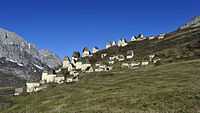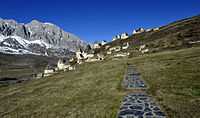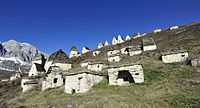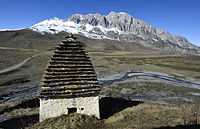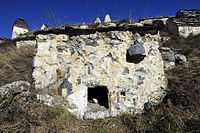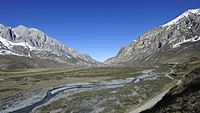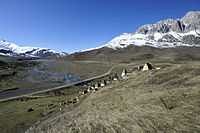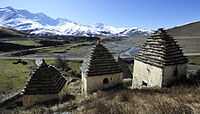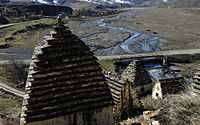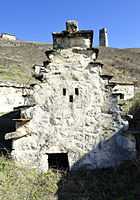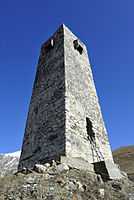Dargavs
| Dargavs (English) Даргавс (Russian) Дæргъæвс (Ossetic) | |
|---|---|
|
- Rural locality - Settlement | |
|
Dargavs and the Gizeldon River | |
.svg.png) Location of the Republic of North Ossetia-Alania in Russia | |
 Dargavs | |
|
| |
| Administrative status | |
| Country | Russia |
| Federal subject | Republic of North Ossetia–Alania |
| Administrative district | Prigorodny District |
| Statistics | |
| Population (2010 Census) | 155 inhabitants[1] |
| Time zone | MSK (UTC+03:00)[2] |
| Dargavs on WikiCommons | |
Dargavs (Ossetian: Дæргъæвс, Dærğævs) is a settlement in Prigorodny District of the Republic of North Ossetia–Alania, Russia, located on the Gizeldon River. Dargavs was a center of Ossetian province of Tagauria.
City of the dead

There is an Alanian[3] necropolis outside the village of Dargavs, called "City of the dead". It comprises 99 different tombs and crypts. Some sources say the oldest of the crypts dates back to the 12th century,[4] though others say the oldest crypt dates back to 14th century[5] and some say it dates to the 16th century.[6][7] At the back of the complex there is a tower, though the top of it is destroyed.
Architecture
The crypts have ridged curved roofs going inwards in steps with a pointed peak at the top. The smaller crypts have flat sides on the front and back yet on the sides they curves inwards and the smallest of the crypts have no roofs at all.
The walls are made up of stone blocks and mortared with most likely lime or clay-lime. The walls have square slits to put in the corpses.
On the inside of the crypts there is a pointed groin vault complex to hold the roof up, though on the smaller once there are pointed barrel vaults.
The bigger crypts can be 2–4 stories high.[8]
Placement and position of buildings
The placement and "plan" is very similar to the Necropolis in Itum-Kali, where the tombs and crypts are placed on hills or mountain sides closely together, though some crypts are located sparsely.
On the highest point, or at least higher up than the rest of the buildings, there must always be a tower to watch over the dead. The crypts also go upward the mountain side in a line with each other, with some of them built into the mountain side.
Old traditions and burials
The people of the nearby village used to bury their dead family and loved ones, often in small wooden "boats" as found by archaeological discoveries. Though there are no navigable rivers nearby the village, it is thought they did this as it was thought that the soul of the dead one had to cross a wide river after death. The dead would be buried with some of their belongings.
It is said that when there would be plagues that wiped out entire families some sick, with no one to bury them, would go into their family crypts and await their death.[7][5]
The crypts that are more sparsely placed are common crypts where people would be buried if there were no one to bury them[4] or if they were not from the village.
There are found many coins in the ground by the complex as Ossetians would throw a coin from the hill for a dead family member and if the coin hit stone it meant that the soul of the dead one had reached heaven. This could also be done in the small wells that are in front of every crypt.
Myths and legends
There are several myths about the cemetery, one of them being a tale that any man who dared to walk in would never come out alive. This is one of the reasons the locals almost never go there.[4][5]
Tourism
There are little to no tourists coming to the area due to the long and tough road. It takes one hour from Vladikavkaz on narrow roads and many hills.
Gallery
See also
References
- ↑ Russian Federal State Statistics Service (2011). "Всероссийская перепись населения 2010 года. Том 1" [2010 All-Russian Population Census, vol. 1]. Всероссийская перепись населения 2010 года (2010 All-Russia Population Census) (in Russian). Federal State Statistics Service. Retrieved June 29, 2012.
- ↑ Правительство Российской Федерации. Федеральный закон №107-ФЗ от 3 июня 2011 г. «Об исчислении времени», в ред. Федерального закона №248-ФЗ от 21 июля 2014 г. «О внесении изменений в Федеральный закон "Об исчислении времени"». Вступил в силу по истечении шестидесяти дней после дня официального опубликования (6 августа 2011 г.). Опубликован: "Российская газета", №120, 6 июня 2011 г. (Government of the Russian Federation. Federal Law #107-FZ of June 31, 2011 On Calculating Time, as amended by the Federal Law #248-FZ of July 21, 2014 On Amending Federal Law "On Calculating Time". Effective as of after sixty days following the day of the official publication.).
- ↑ "Dargavs definition of Dargavs in the Free Online Encyclopedia". Encyclopedia2.thefreedictionary.com. Retrieved 2014-02-15.
- ↑ 4.0 4.1 4.2 "Dargavs - City of the Dead". Chill Hour. 2013-01-18. Retrieved 2014-02-15.
- ↑ 5.0 5.1 5.2 "Mysterious and magnificent ancient cemetery of North Ossetia — RT News". Rt.com. 2011-06-11. Retrieved 2014-02-15.
- ↑ "The City of the Dead — RT Op-Edge". Rt.com. 2011-05-17. Retrieved 2014-02-15.
- ↑ 7.0 7.1 "Dargavs - Russia's City of the Dead | Oddity Central - Collecting Oddities". Oddity Central. 2011-12-19. Retrieved 2014-02-15.
- ↑ "Dargavs definition of Dargavs in the Free Online Encyclopedia". Encyclopedia2.thefreedictionary.com. Retrieved 2014-02-15.

